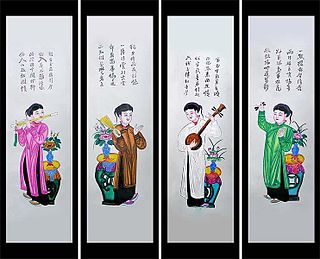
Cantonese or Guangdong cuisine, also known as Yue cuisine, is the cuisine of Guangdong province of China, particularly the provincial capital Guangzhou, and the surrounding regions in the Pearl River Delta including Hong Kong and Macau. Strictly speaking, Cantonese cuisine is the cuisine of Guangzhou or of Cantonese speakers, but it often includes the cooking styles of all the speakers of Yue Chinese languages in Guangdong.

Five-spice powder is a spice mixture of five or more spices used predominantly in almost all branches of Chinese cuisine. The five flavors of the spices refers to the five traditional Chinese elements. The addition of eight other spices creates thirteen-spice powder (十三香), which is used less commonly.

Fusion cuisine is a cuisine that combines elements of different culinary traditions that originate from different countries, regions, or cultures. Cuisines of this type are not categorized according to any one particular cuisine style and have played a part in many contemporary restaurant cuisines since the 1970s.

Vietnamese cuisine encompasses the foods and beverages originated from Vietnam. Meals feature a combination of five fundamental tastes : sweet, salty, bitter, sour, and spicy. The distinctive nature of each dish reflects one or more elements, which are also based around a five-pronged philosophy. Vietnamese recipes use ingredients like lemongrass, ginger, mint, Vietnamese mint, long coriander, Saigon cinnamon, bird's eye chili, lime, and Thai basil leaves. Traditional Vietnamese cooking has often been characterised as using fresh ingredients, not using much dairy or oil, having interesting textures, and making use of herbs and vegetables. The cuisine is also low in sugar and is almost always naturally gluten-free, as many of the dishes are rice-based instead of wheat-based, made with rice noodles, papers and flour.

Fish sauce is a liquid condiment made from fish or krill that have been coated in salt and fermented for up to two years. It is used as a staple seasoning in East Asian cuisine and Southeast Asian cuisine, particularly Myanmar, Cambodia, Laos, Philippines, Thailand, and Vietnam. Some garum-related fish sauces have been used in the West since the Roman times.

Egg foo young is an omelette dish found in Chinese cuisine. The name comes from the Cantonese language. Egg foo young is derived from fu yung egg slices, a mainland Chinese recipe from Guangdong.

The following outline is provided as an overview of and topical guide to the preparation of food:

Gỏi cuốn, nem cuốn, salad roll, summer roll, fresh spring roll, or rice paper roll is a Vietnamese dish traditionally consisting of pork, prawn, vegetables, bún, and other ingredients wrapped in bánh tráng. Unlike other spring roll dishes, which are believed to originate from China, Vietnamese gỏi cuốn is a national creation using bánh tráng.

Thai basil called káu-chàn-thah in Taiwan, is a type of basil native to Southeast Asia that has been cultivated to provide distinctive traits. Widely used throughout Southeast Asia, its flavor, described as anise- and licorice-like and slightly spicy, is more stable under high or extended cooking temperatures than that of sweet basil. Thai basil has small, narrow leaves, purple stems, and pink-purple flowers.

Limnophila aromatica, the rice paddy herb, is a tropical flowering plant in the family Plantaginaceae. It is native to Southeast Asia, where it flourishes in hot temperatures and grows most often in watery environments, particularly in flooded rice fields. It is called ngò ôm or ngò om or ngổ in Vietnam and used as an herb and also cultivated for use as an aquarium plant. The plant was introduced to North America in the 1970s due to Vietnamese immigration following the Vietnam War. It is called "ma om" (ម្អម) in Khmer. It is used in traditional Cambodian soup dishes and Southern Vietnamese cuisine. It can grow in flooded rice paddies during wet season but it grows best on drained but still wet sandy soil of harvested rice paddies for a few months after the rainy season ended. It dies out soon after it flowers. Rural Cambodians often harvest them and put them on the roof of their houses to dry for later use.

Vietnamese cuisine includes many types of noodles. They come in different colors and textures and can be served wet or dry, hot or cold, and fresh (tươi), dried (khô), or fried.

Khanom chan is an ancient Thai khanom, or dessert, made of tapioca flour, rice flour, and coconut milk, among other ingredients. Originating from the Sukhothai Period, the dessert is a staple snack in Thai cuisine, and Thai people usually prepare it for auspicious ceremonies.

The cuisines of Oceania include those found on Australia, New Zealand, and New Guinea, and also cuisines from many other islands or island groups throughout Oceania.

Hoisin sauce is a thick, fragrant sauce commonly used in Cantonese cuisine as a glaze for meat, an addition to stir fry, or as dipping sauce. It is dark-coloured, sweet and salty. Although regional variants exist, hoisin sauce usually includes soybeans, fennel, red chili peppers, and garlic. Vinegar, five-spice powder, and sugar are also commonly added.

A banana cake is a cake prepared using banana as a primary ingredient and typical cake ingredients. It can be prepared in various manners, including as a layer cake, as muffins and as cupcakes. Steamed banana cake is found in Chinese, Malaysian, Indonesian and Vietnamese cuisine. In the Philippines, the term "banana cake" refers to banana bread introduced during the American colonial period of the Philippines.
Húng lìu, named after basil, is a spice mixture of four or five spices found in Vietnamese cuisine.

Mì (mỳ) or mi is a Vietnamese term for yellow wheat noodles. It can also refer to egg noodles. They were brought over to Vietnam as wonton noodles by Chinese immigrants. The Vietnamese version of wonton noodles is mì hoành thánh. The noodles can be either thin or wide and are commonly used in súp mì and mì khô.






























































